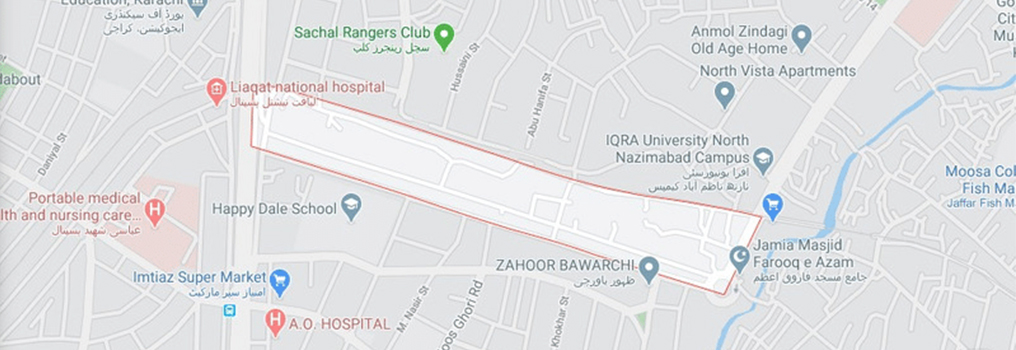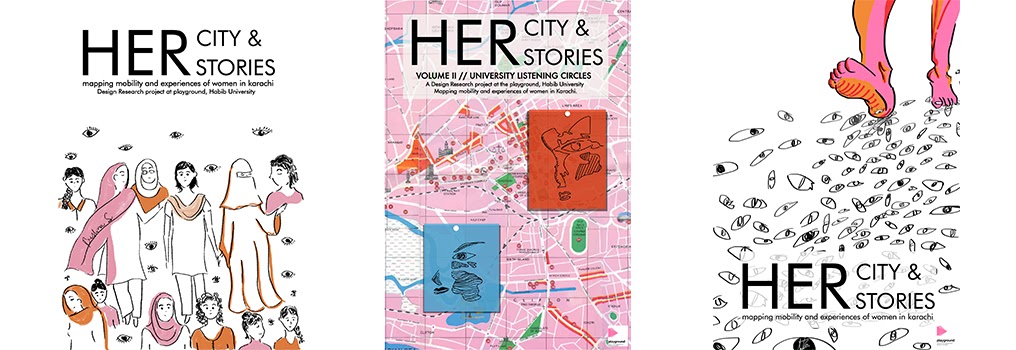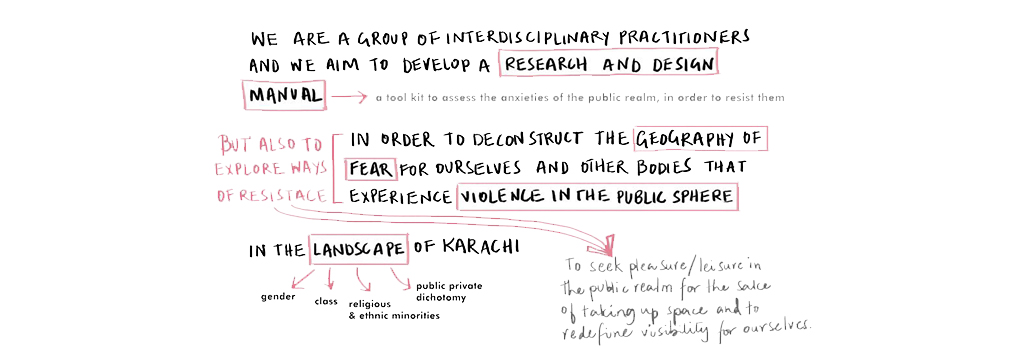Course Description
Over the years, the techniques of mapping have evolved to include not only the representation of physical space, but also the construction of experiential realities. The course explores ways of understanding, observing and interpreting events, places and objects, and learning the vocabulary of map design, with an overview of types of maps and mapmaking tools. The act of cartography is explored as a design research process, and the techniques of mapping—analyzing and making meaning of raw data—are used as a comparative analytic tool and as a way to uncover hidden meanings between data and reality.
Cartography: History and Practice of Mapmaking
December 30, 2020 by
Cultural Mapping
October 5, 2020 by
This project involved identifying cultural trails to document and preserve the rich heritage of Old Town, Saddar, based on insights from field mapping and interviews with local community members. The research team aimed to compile the data in a human-centered format to showcase the stories that emerged from the field research.
The project culminated in producing three trails: the Aroma, Sacred, and Literary. Insights from oral history accounts were used, allowing readers to navigate through the Serai and Arambagh quarters of Saddar.
The documented research includes site photographs, excerpts from interviews and a guide map with suggested routes for people visiting the Old Town for the first time. The intent behind this project was to highlight the area’s vibrant cultural heritage in a way that is easily accessible to the general public.
The project culminated in producing three trails: the Aroma, Sacred, and Literary. Insights from oral history accounts were used, allowing readers to navigate through the Serai and Arambagh quarters of Saddar.
The documented research includes site photographs, excerpts from interviews and a guide map with suggested routes for people visiting the Old Town for the first time. The intent behind this project was to highlight the area’s vibrant cultural heritage in a way that is easily accessible to the general public.
Mapping Festivity
October 5, 2020 by
The Mapping Festivity project focuses on highlighting the history, complexity, diversity and evolution of the wedding halls in Karachi, and explores their evolution over time, to understand how the different religious and ethnic communities living in the city celebrate festivities like weddings. The team hopes to present the different wedding practices and rituals as microcosms of Pakistan, and understand the social, cultural, and urban forces that have influenced and transformed the weddings over time.
Members of 29 different communities across Karachi were interviewed, to understand the different cultural and wedding practices that were unique to each community’s celebrations. Narratives and personal anecdotes were collected in the form of Oral Histories, with families and groups elaborating on the values, rituals, practices and interests of their communities in festivities like weddings. The project reveals how all of these different communities come together to give Karachi its lively, vibrant and resilient vibrant character, amidst the existing political, social and cultural divides.
The interview narratives and findings have been presented in the form of photographs, network maps, diagrams and tarot cards, each of which add to the rich, graphic details of the analysis, thus, interconnecting community cultures and practices with the wider dynamic of celebrating festivities.
In contemporary Pakistan, weddings serve as more than just social institutions. They knit together a multiplicity of societal, cultural and economic norms, that are performed in high energy festivities and celebrations. They open up a space for members of different industries and social classes to coexist in harmony.
‘Shaadi’ (Wedding) Halls are studied as an architectural type that emerged to serve these wedding performances, and a stage that supports the various wedding industries like The project explores the urban transformation undergone by these wedding halls in the past decade, from close-knit gardens, street and home-based weddings, to weddings in present-day Karachi taking place in halls, marquees and banquets. The project also views wedding halls as stages that support various wedding industries such as food catering, event planning, decor, beauty salons and fashion.
The team presented their work at the La Biennale di Venezia – 17th International Architecture Exhibition in 2021.
The project in exhibition can be viewed here: https://www.nationalpavilionofpakistan.org/#
Members of 29 different communities across Karachi were interviewed, to understand the different cultural and wedding practices that were unique to each community’s celebrations. Narratives and personal anecdotes were collected in the form of Oral Histories, with families and groups elaborating on the values, rituals, practices and interests of their communities in festivities like weddings. The project reveals how all of these different communities come together to give Karachi its lively, vibrant and resilient vibrant character, amidst the existing political, social and cultural divides.
The interview narratives and findings have been presented in the form of photographs, network maps, diagrams and tarot cards, each of which add to the rich, graphic details of the analysis, thus, interconnecting community cultures and practices with the wider dynamic of celebrating festivities.
In contemporary Pakistan, weddings serve as more than just social institutions. They knit together a multiplicity of societal, cultural and economic norms, that are performed in high energy festivities and celebrations. They open up a space for members of different industries and social classes to coexist in harmony.
‘Shaadi’ (Wedding) Halls are studied as an architectural type that emerged to serve these wedding performances, and a stage that supports the various wedding industries like The project explores the urban transformation undergone by these wedding halls in the past decade, from close-knit gardens, street and home-based weddings, to weddings in present-day Karachi taking place in halls, marquees and banquets. The project also views wedding halls as stages that support various wedding industries such as food catering, event planning, decor, beauty salons and fashion.
The team presented their work at the La Biennale di Venezia – 17th International Architecture Exhibition in 2021.
The project in exhibition can be viewed here: https://www.nationalpavilionofpakistan.org/#
TransDesign Practicum
October 5, 2020 by
Course Description
How does design operate in a complex world rife with ‘wicked problems?’ This course places design and its practices under the spotlight, to critically examine the role of design over the last century, as it contributed to the intractable problems we find ourselves in today. These problems include issues like poverty, income disparity and global warming, and are referred to as ‘wicked problems,’ as they lack a definitive formula and are seemingly impossible to solve. The course raises questions about the contextual relevance of design, particularly in the global south, and its relationship to global design conversations. Students are given the opportunity to analytically position design practices in a 21st century context, and to think reflectively and critically about various design practices in order to assess the limitations and possibilities of the contributions that they can have towards social change. Discussions projecting from existing conditions to future possibilities, allow the students to speculate about future directions in design practices. The course consists of seminars with discussions, readings and presentations, along with a practice-based studio component. While the seminars look into the intellectual foundations of a transdisciplinary design practice, the studio component immerses students in a classic wicked problem, as they develop their own understanding of this new practice.
How does design operate in a complex world rife with ‘wicked problems?’ This course places design and its practices under the spotlight, to critically examine the role of design over the last century, as it contributed to the intractable problems we find ourselves in today. These problems include issues like poverty, income disparity and global warming, and are referred to as ‘wicked problems,’ as they lack a definitive formula and are seemingly impossible to solve. The course raises questions about the contextual relevance of design, particularly in the global south, and its relationship to global design conversations. Students are given the opportunity to analytically position design practices in a 21st century context, and to think reflectively and critically about various design practices in order to assess the limitations and possibilities of the contributions that they can have towards social change. Discussions projecting from existing conditions to future possibilities, allow the students to speculate about future directions in design practices. The course consists of seminars with discussions, readings and presentations, along with a practice-based studio component. While the seminars look into the intellectual foundations of a transdisciplinary design practice, the studio component immerses students in a classic wicked problem, as they develop their own understanding of this new practice.
Speculative & Critical Design
October 5, 2020 by
Course Description
As organizations, governments, and corporations face rapid change and uncertain times, new ways of designing for a preferable future is imperative. Whereas human-centered design and design thinking focus on the near future, this course will look at how to design for longer-term. In this course, students learn various speculative design techniques and gain hands-on experience with a variety of forecasting methods, including trendspotting and STEEP analysis. Structured around understanding the field of Speculative & Critical Design (SCD), this studio-based course covers its history, scope, core concepts, criticism and application to conduct future-facing design research, using design projects as the main vehicle for exploration. SCD is explored from multiple perspectives using different mediums such as films, design projects, essays and published papers. Working with both practice and theory, participants learn to use SCD methods as a medium to raise critical questions and to provoke debate on what alternative futures could be. The goal is to be unconstrained by ‘what is’, and to embrace the ‘what if’. The work in this course is transdisciplinary, and by the end of this course, participants develop an understanding of techniques used to address ‘wicked problems’ using a fictitious approach, and get the opportunity to apply their newly acquired knowledge through a project.
As organizations, governments, and corporations face rapid change and uncertain times, new ways of designing for a preferable future is imperative. Whereas human-centered design and design thinking focus on the near future, this course will look at how to design for longer-term. In this course, students learn various speculative design techniques and gain hands-on experience with a variety of forecasting methods, including trendspotting and STEEP analysis. Structured around understanding the field of Speculative & Critical Design (SCD), this studio-based course covers its history, scope, core concepts, criticism and application to conduct future-facing design research, using design projects as the main vehicle for exploration. SCD is explored from multiple perspectives using different mediums such as films, design projects, essays and published papers. Working with both practice and theory, participants learn to use SCD methods as a medium to raise critical questions and to provoke debate on what alternative futures could be. The goal is to be unconstrained by ‘what is’, and to embrace the ‘what if’. The work in this course is transdisciplinary, and by the end of this course, participants develop an understanding of techniques used to address ‘wicked problems’ using a fictitious approach, and get the opportunity to apply their newly acquired knowledge through a project.
Empathy Mapping
September 21, 2020 by

The 5 stages of Design Thinking
This project involves using Design Thinking tools to devise a user-facing strategy for big corporations like Karachi Electric (KE), to improve their interactions with their customers, in relation to utility bill payments. The project targeted consumers in the Mujahid Colony residential area.
Mujahid Colony, Google Maps.
For this purpose, the research team conducted both primary and secondary research, including desk research/secondary data analysis, scheduled meetings with the corporation officials at their head office, drafting questionnaire guides and conducting field visits and on-site interviews with residents of the selected area. The research team utilized the data insights and conducted online Design Thinking and Ideation workshops with the corporation’s team, with the aim of including a diverse pool of participants from various departments. The purpose of these workshops is to bring together people from different fields of expertise, to brainstorm strategies to offer their unique perspectives on the topic. Snapshots from our brainstorming sessions with the corporation
Snapshots from our brainstorming sessions with the corporation
Her City, Her Stories
September 21, 2020 by
 Her City, Her Stories is a student led research project that uses a range of design research methodologies, including, but not limited to the practice of human-centered design, to explore and document women’s real-life experiences with mobility in the city of Karachi. The subjects of this study are women lying in the age bracket of 16 – 30 years, from various socio-economic backgrounds, who usually travel independently, around the city.
This research is comprehensive, and examines the various different transport modes available to women in the city, to better understand the relationship between the two. A comparative study will be conducted to see how the issues faced by women in Karachi, fare against issues faced by women in other South Asian cities. Finally, the study will explore different ways of designing impactful, speculative and empathetic interventions, centered around the themes of gender and mobility.
Her City, Her Stories is a student led research project that uses a range of design research methodologies, including, but not limited to the practice of human-centered design, to explore and document women’s real-life experiences with mobility in the city of Karachi. The subjects of this study are women lying in the age bracket of 16 – 30 years, from various socio-economic backgrounds, who usually travel independently, around the city.
This research is comprehensive, and examines the various different transport modes available to women in the city, to better understand the relationship between the two. A comparative study will be conducted to see how the issues faced by women in Karachi, fare against issues faced by women in other South Asian cities. Finally, the study will explore different ways of designing impactful, speculative and empathetic interventions, centered around the themes of gender and mobility.
 As part of this initiative, the Her City, Her Stories team planned on conducting several workshops. However, given the limitations due to the Covid-19 pandemic, the team had to re-evaluate and explore options on how to make this research more accessible and inclusive, while continuing to abide by all health and safety measures. They started by hosting a series of online listening circles for women. Community and behenchara are key aspects for resisting isolation, hence the idea of these workshops is to bring women together to have a healthy dialogue about their relationship to the city they live in, to validate their experiences, and envision a city where women feel free. The team continues to work on making these listening circles more interactive and engaging.
The workshops also include different mapping exercises. The technique of Encounter Mapping is used to get a visual representation of the experiences that women have in the spaces they visit regularly, and the ways through which they adapt to the city. The second activity is conducted using Google My Maps, to mark the walking and driving routes that are part of the participants’ daily commute, with the aim of generating heat maps of safe and unsafe zones. The third activity is a speculative future’s activity conducted on Mural. Women are asked to envision their preferred future of Karachi 2050.
Moving forward, the team plans on taking into account how the pandemic has affected the mobility patterns of the citizens of Karachi, and its impact on the future of the city.
As part of this initiative, the Her City, Her Stories team planned on conducting several workshops. However, given the limitations due to the Covid-19 pandemic, the team had to re-evaluate and explore options on how to make this research more accessible and inclusive, while continuing to abide by all health and safety measures. They started by hosting a series of online listening circles for women. Community and behenchara are key aspects for resisting isolation, hence the idea of these workshops is to bring women together to have a healthy dialogue about their relationship to the city they live in, to validate their experiences, and envision a city where women feel free. The team continues to work on making these listening circles more interactive and engaging.
The workshops also include different mapping exercises. The technique of Encounter Mapping is used to get a visual representation of the experiences that women have in the spaces they visit regularly, and the ways through which they adapt to the city. The second activity is conducted using Google My Maps, to mark the walking and driving routes that are part of the participants’ daily commute, with the aim of generating heat maps of safe and unsafe zones. The third activity is a speculative future’s activity conducted on Mural. Women are asked to envision their preferred future of Karachi 2050.
Moving forward, the team plans on taking into account how the pandemic has affected the mobility patterns of the citizens of Karachi, and its impact on the future of the city.